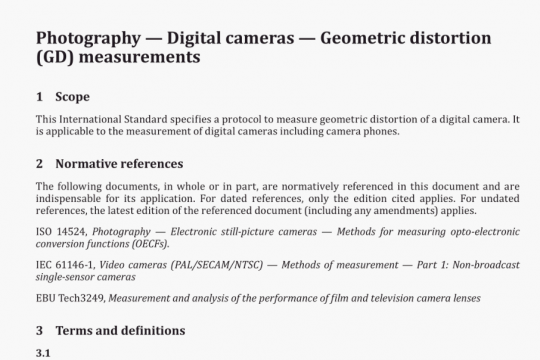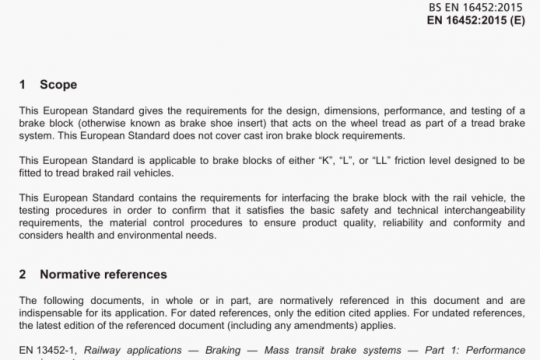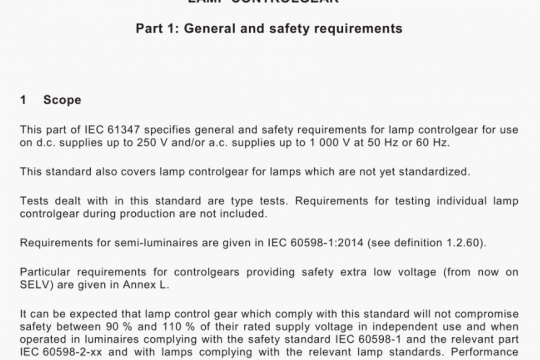BS EN 1021-1:2014 pdf free
BS EN 1021-1:2014 pdf free.Furniture – Assessment of the ignitability of upholstered furniture Part 1: lgnition source smouldering cigarette.
To subject an assembly of upholstery materials to a smouldering ignition source. The assembly is arranged to represent in stylised form a junction between a seat and back (Or seat arid arm) such as might occur in a typical chair. The ignitability of an assembly is determined by applying a smouldering ignition source such as a cigarette. The test method measures the ignitability of the overall composite of materials, i.e. outer cover, inner cover, filling etc., as constructed on the test rig. The tests give an indication of, but cannot guarantee, the ignition behaviour of the finished item of furniture. The results shall not be stated as being applicable to the general behaviour of any individual component (see also Annex A).
NOTE Test specimens prepared from materials taken from furniture that has been used may give different results to the same materials before use.
5 Health and safety of operators
5.1 General
The test method specified in this European Standard presents a considerable hazard; suitable precautions shall be taken.
5.2 Enclosure
For safety, the test should be conducted in a non-combustible fume cupboard. If such a cupboard is not available, a test enclosure should be constructed (see 6.2) so that the operator is protected from the fumes.
5.3 Extinguishers
Adequate means of extinguishing the assembly should be provided bearing in mind that some combinations may produce severe flaming during the test. A hand andJor fixed water spray which can be directed over the burning area can be useful. Other means such as suitable fire extinguishers, fire blankets and a bucket of water will assist.
In some cases smouldering may be difficult to extinguish completely and complete immersion in water may be necessary.
6 Apparatus
6.1 Test rig
A suitable test rig is illustrated in Figures 1 and 2. It shall consist of two rectangular frames hinged together and capable of being locked at right angles to each other.
The sides and hinge edges of the frames shall be made from nominal 25 mm x 3 mm steel flat bar and shall securely ho’d mesh steel platforms set (6 ± 1) mm below the top edge of the frames. (Mesh size should be such that an open mesh area of approximately 15 mm2 to 150 mm2 exists).
The upper edge of the vertical frame and the front edge of the horizontal frame shall be steel end plates
450 mm x 65 mm x 3 mm to prevent the test tilling moving during the assembly of the test specimen (see
Figures 1 and 2).
The internal width and height of the back frame shall be (450 ± 2) mm x (300 ± 2) mm and the width and depth of the base frame (450 ±2) mm x (150 ± 2) mm. A standard edging section may be used around the mesh steel platform to give protection and greater rigidity.
The sides of the frame shall extend beyond the back of each frame to provide for the hinge holes and to form the back legs. The hinge rod shall be of nominal 10 mm diameter steel, continuous across the back of the rig and its axis (22,5 ± 0,5) mm beyond the back member of each frame.
The frames shall be lockable at right angles by a bolt or pin through each of the pairs of members forming the back legs. The front legs may be welded across the front corners of the base frame. The height of the legs shall be such as to leave a gap not less than 50 mm high between the base and frame and the supporting surface.
For the tests the rigs shall be sited within the enclosure (see 6.2) and the testing shall be performed in a basically draught-free environment permitting an adequate supply of air and removal of smoke from the area of the apparatus.BS EN 1021-1 pdf download.




